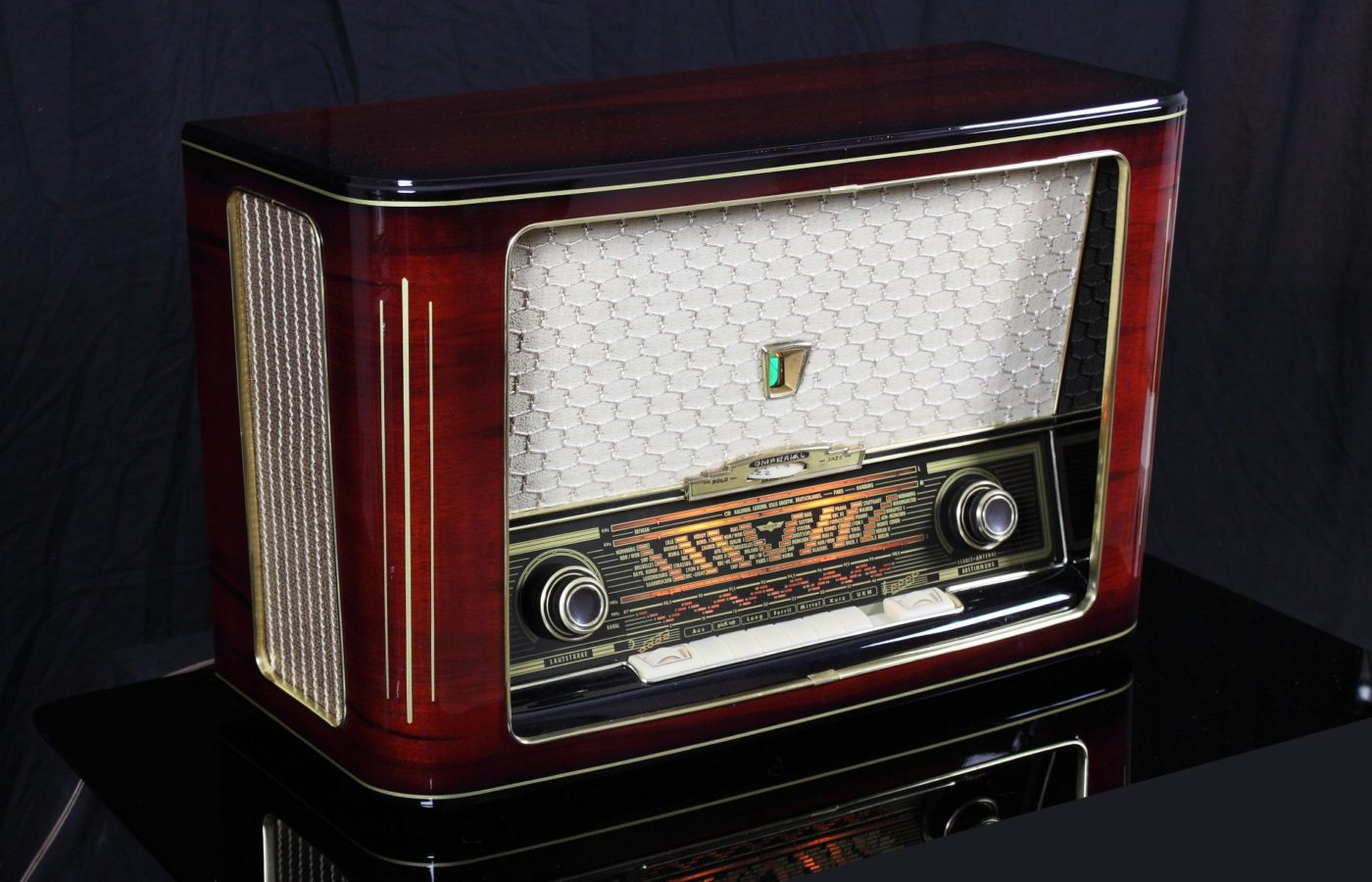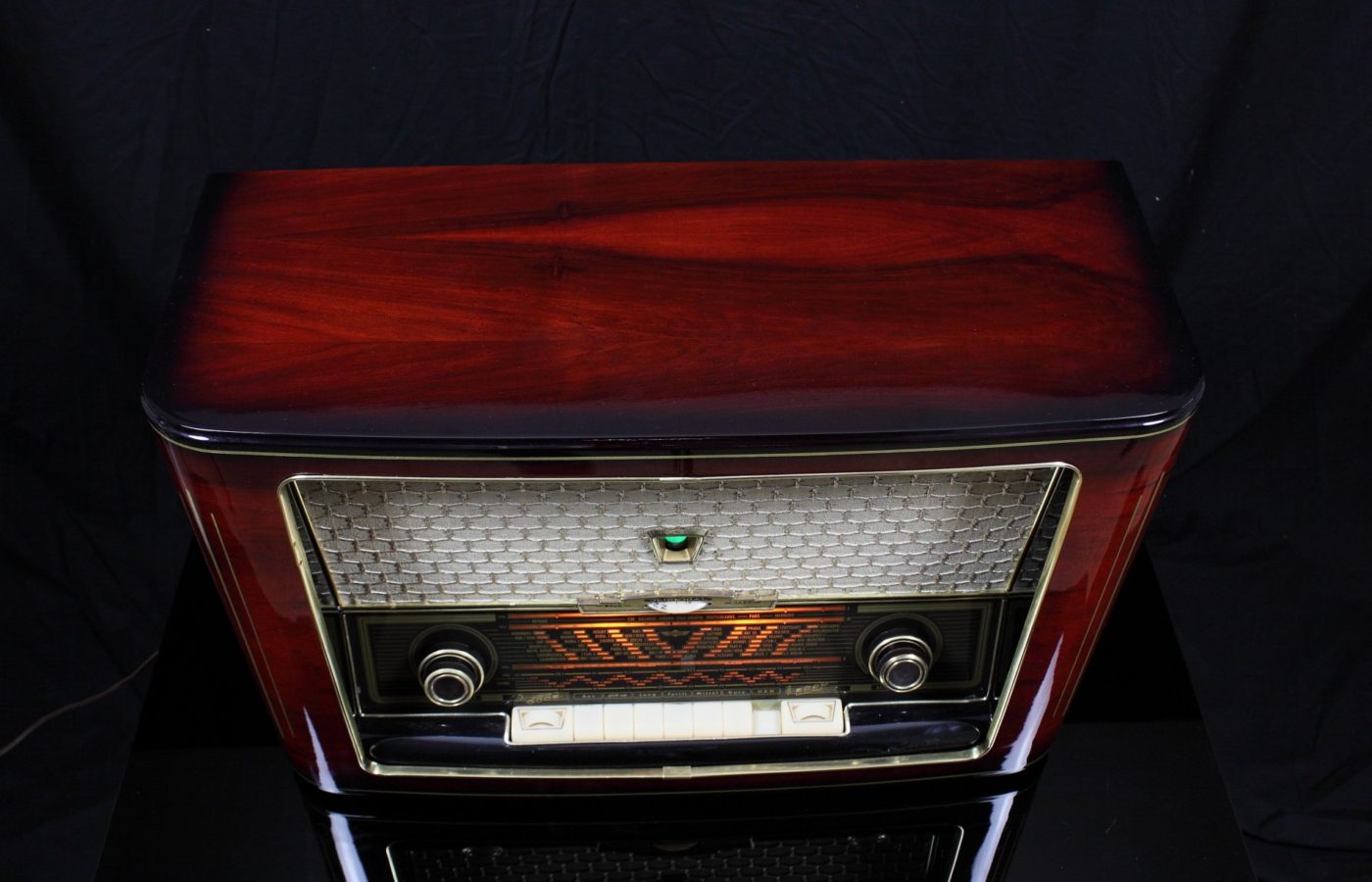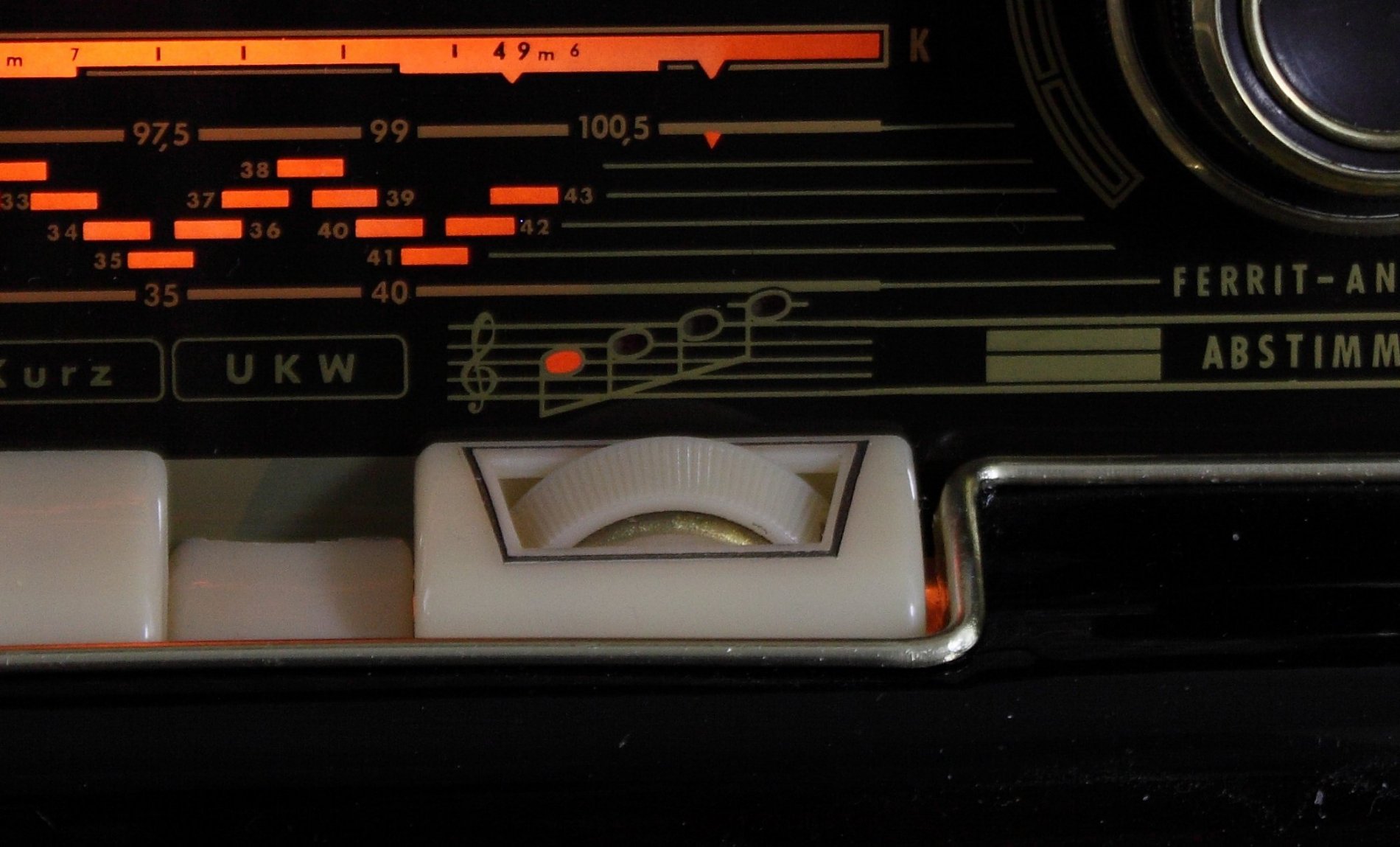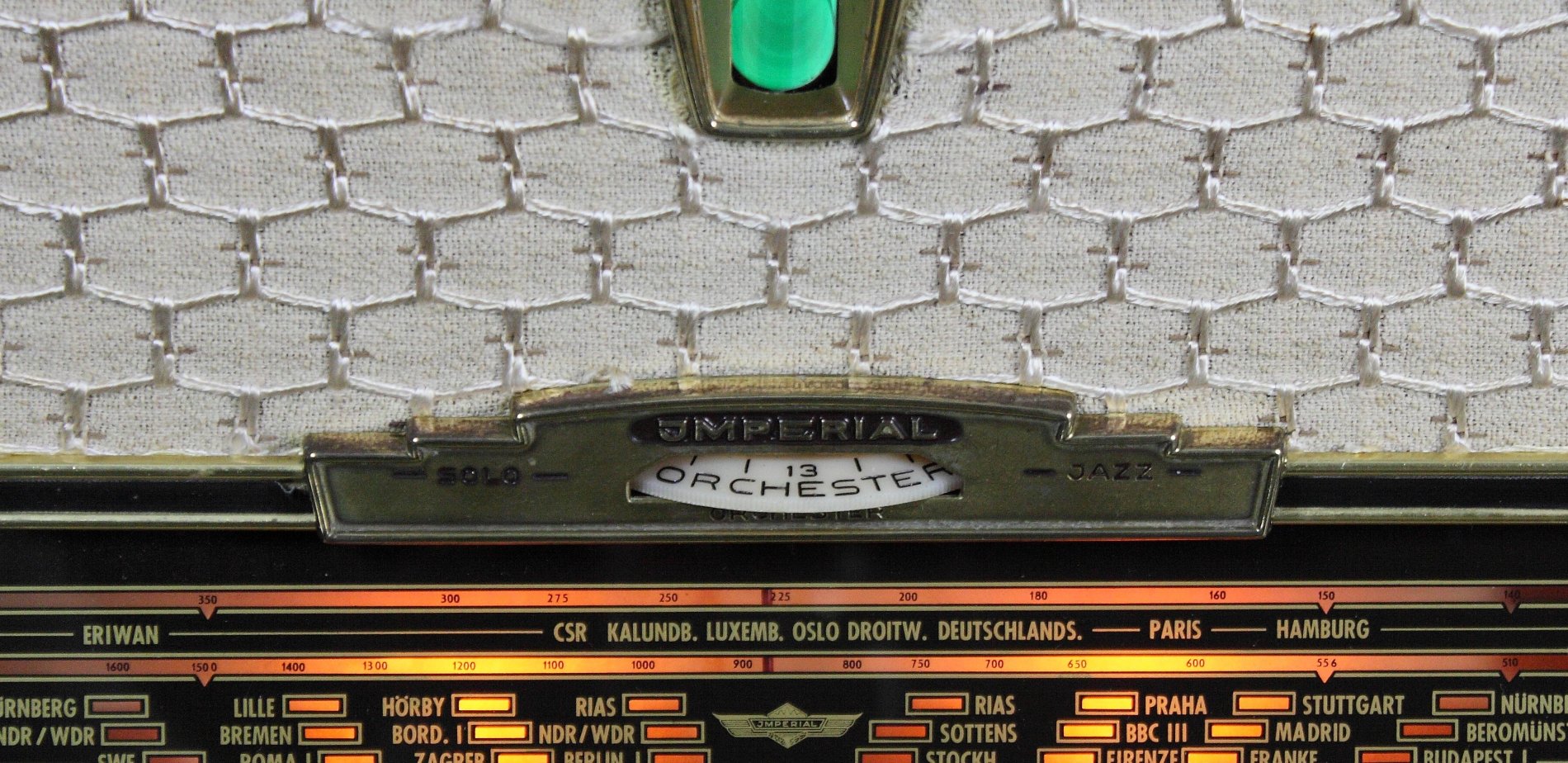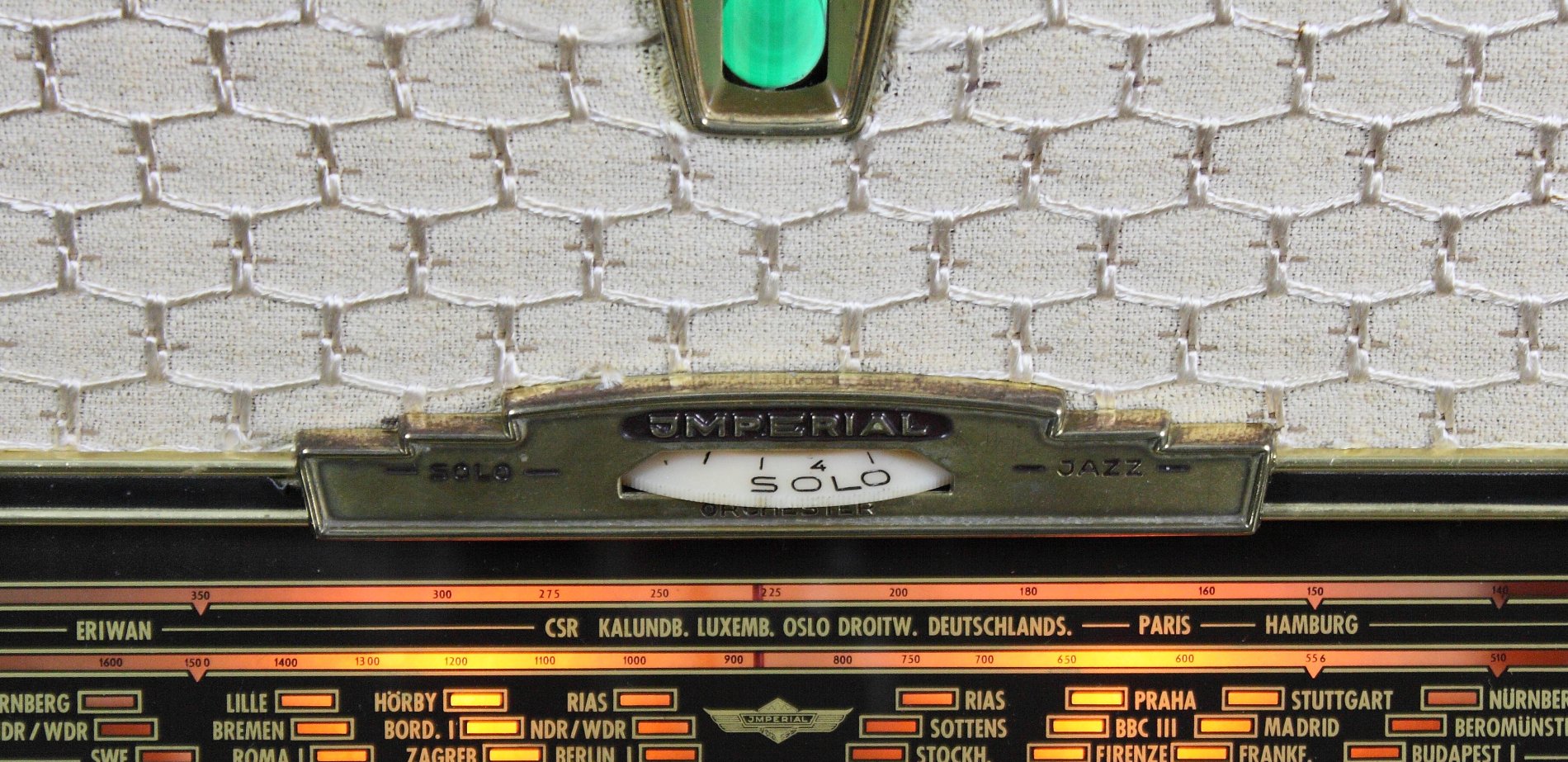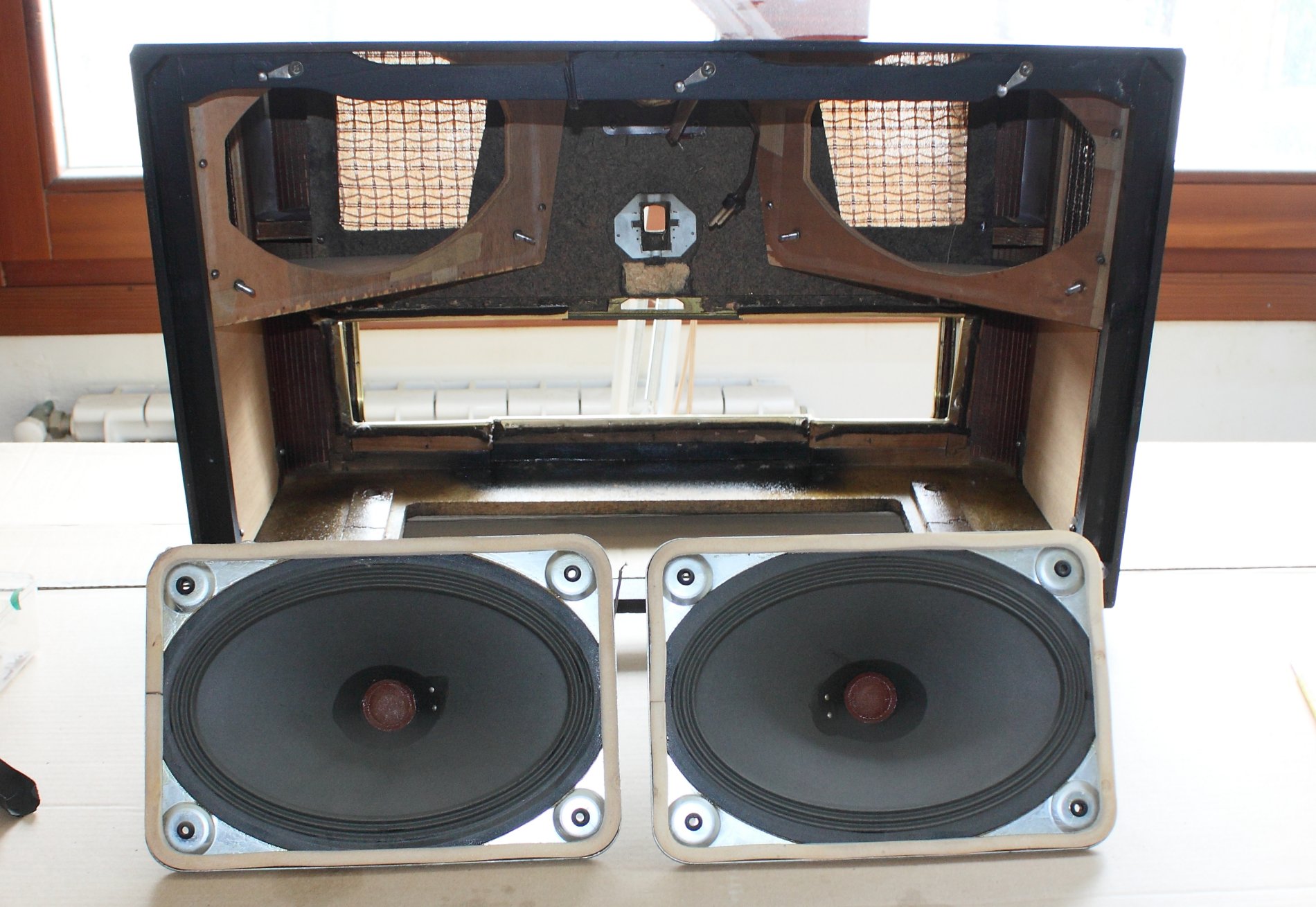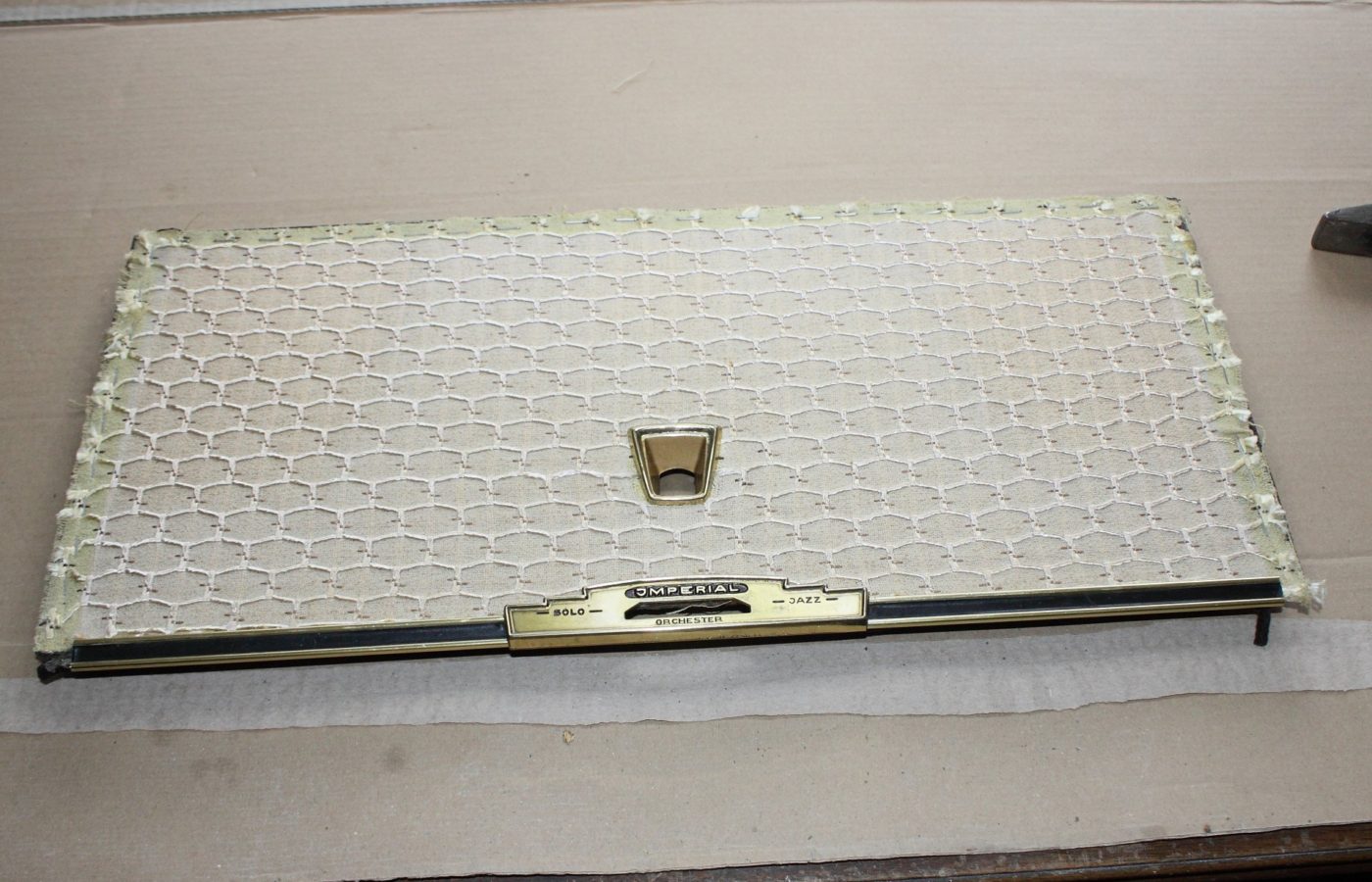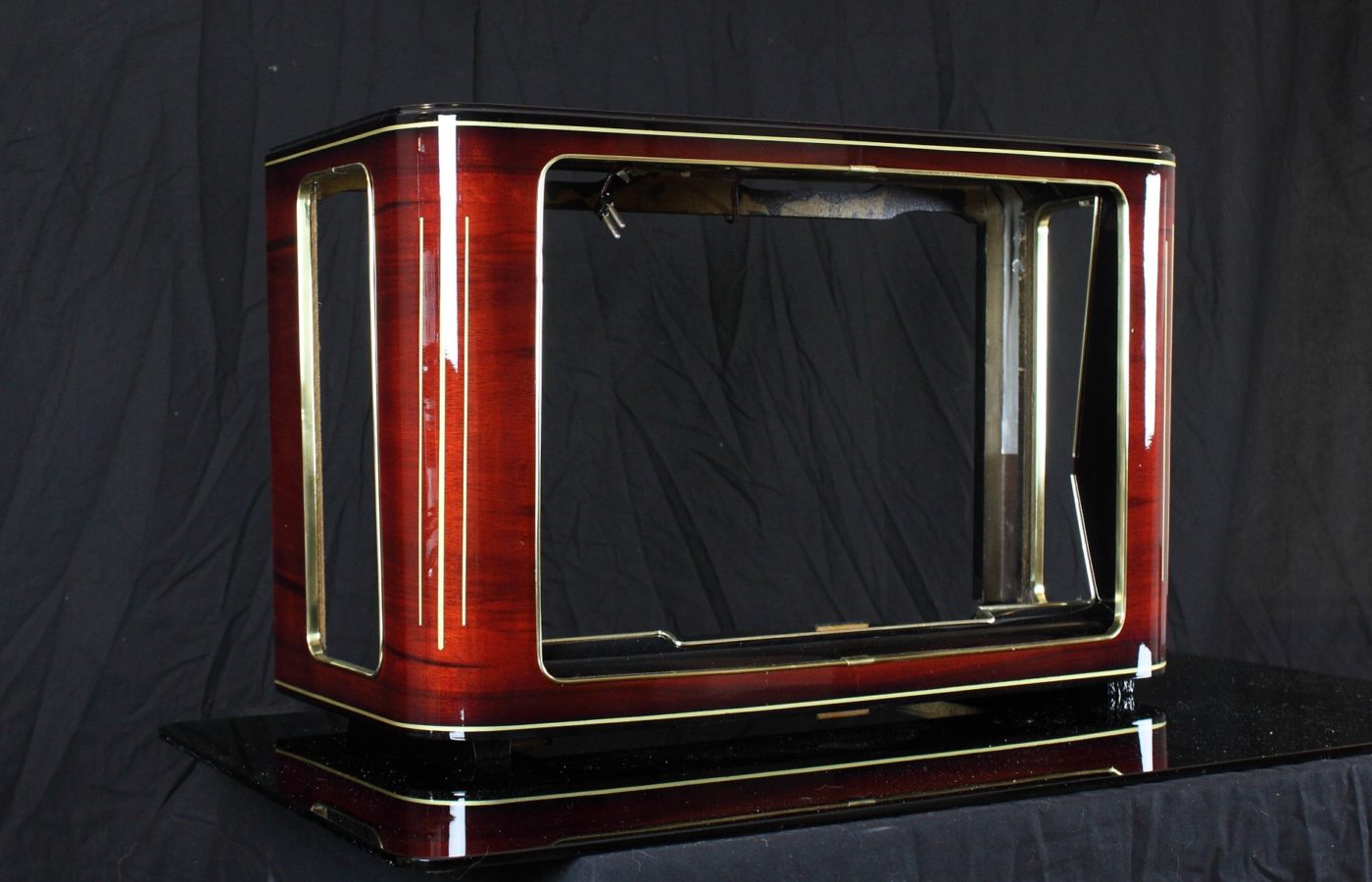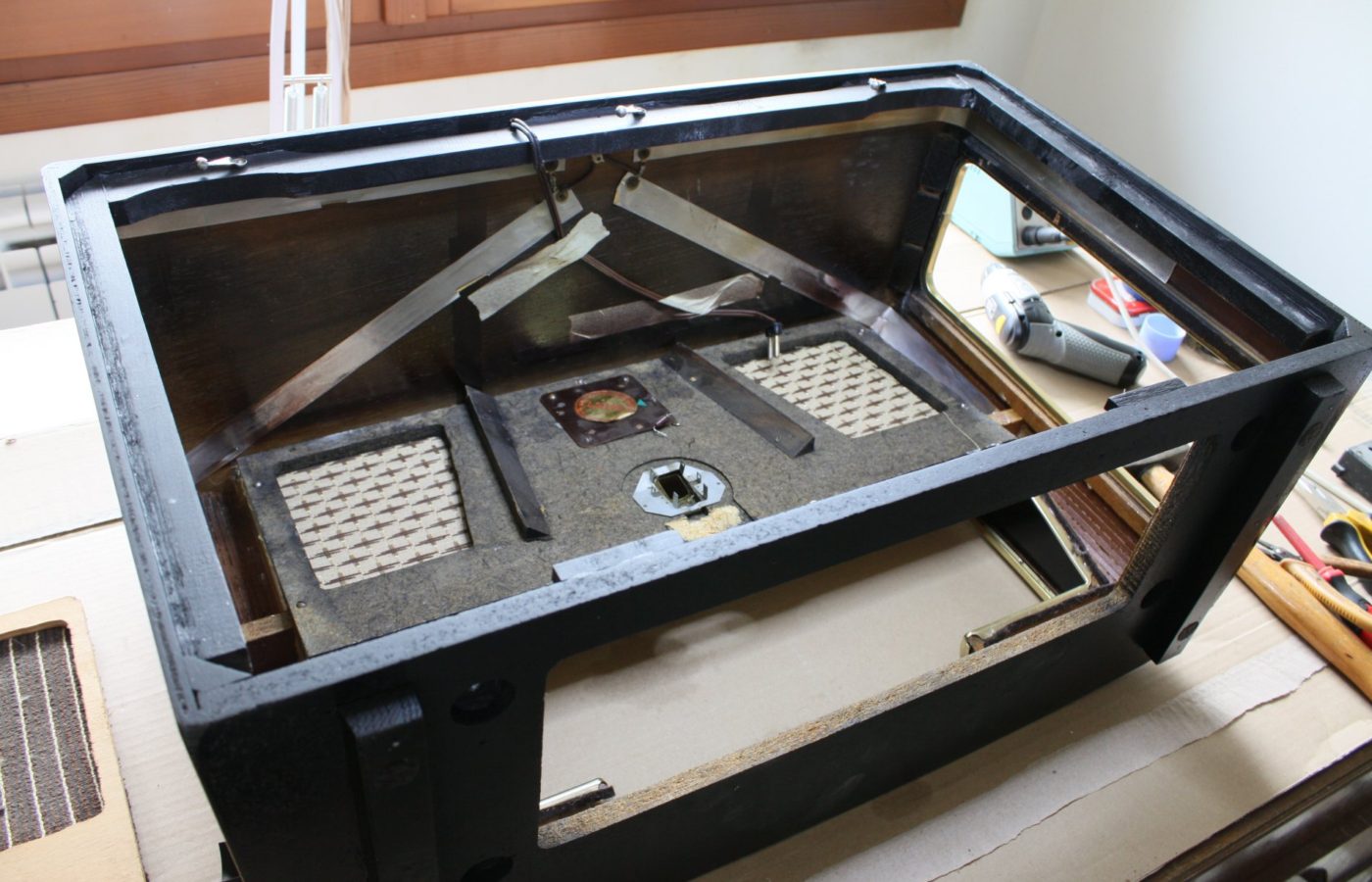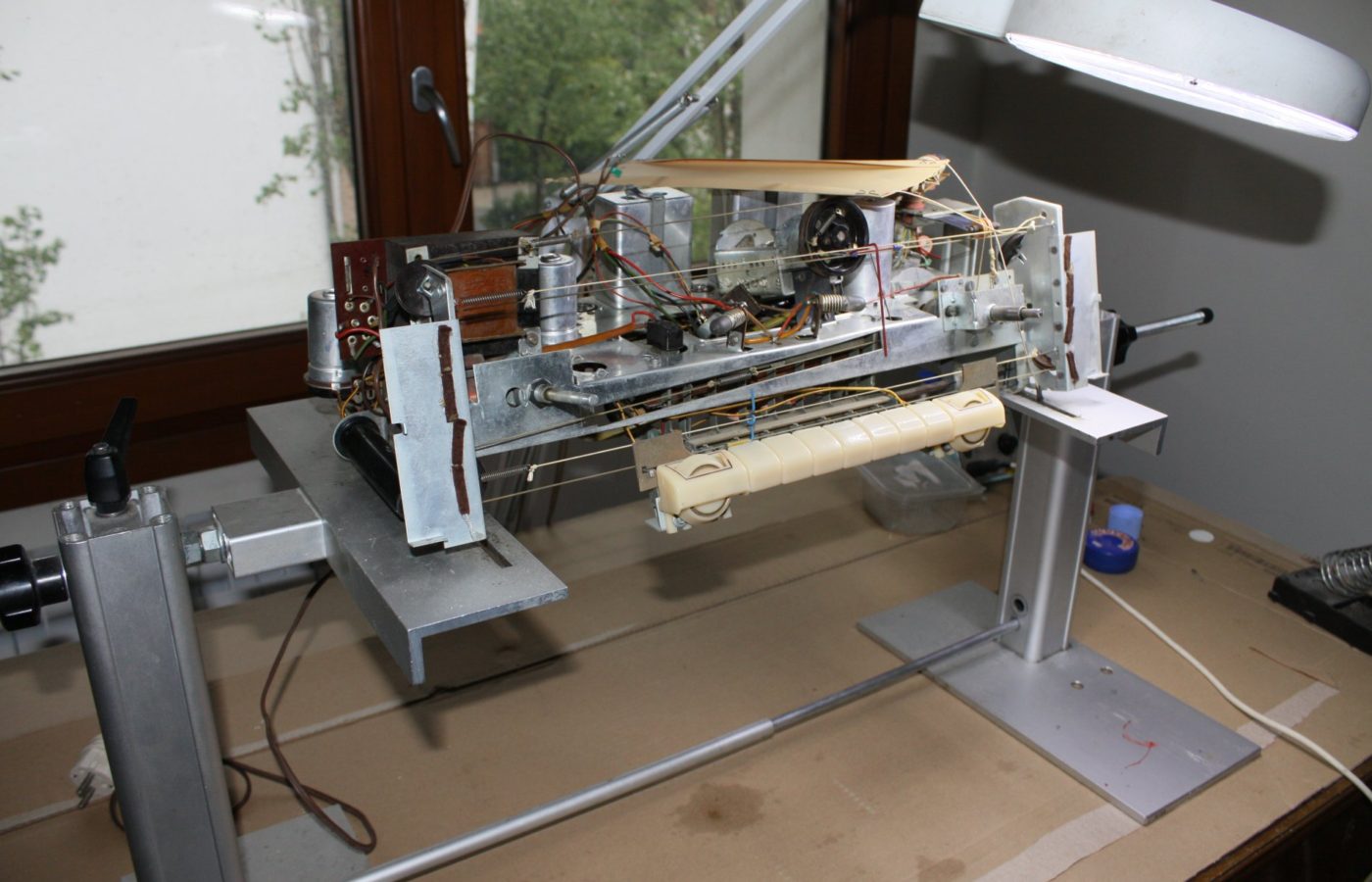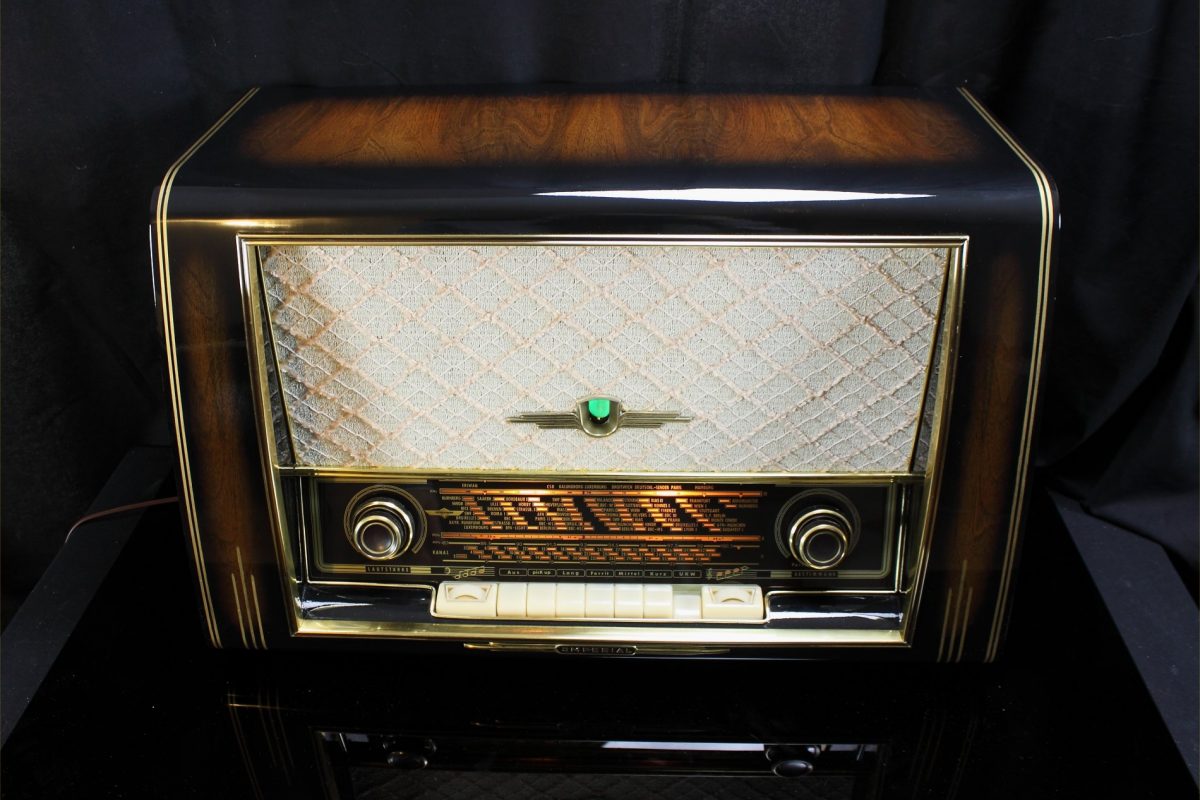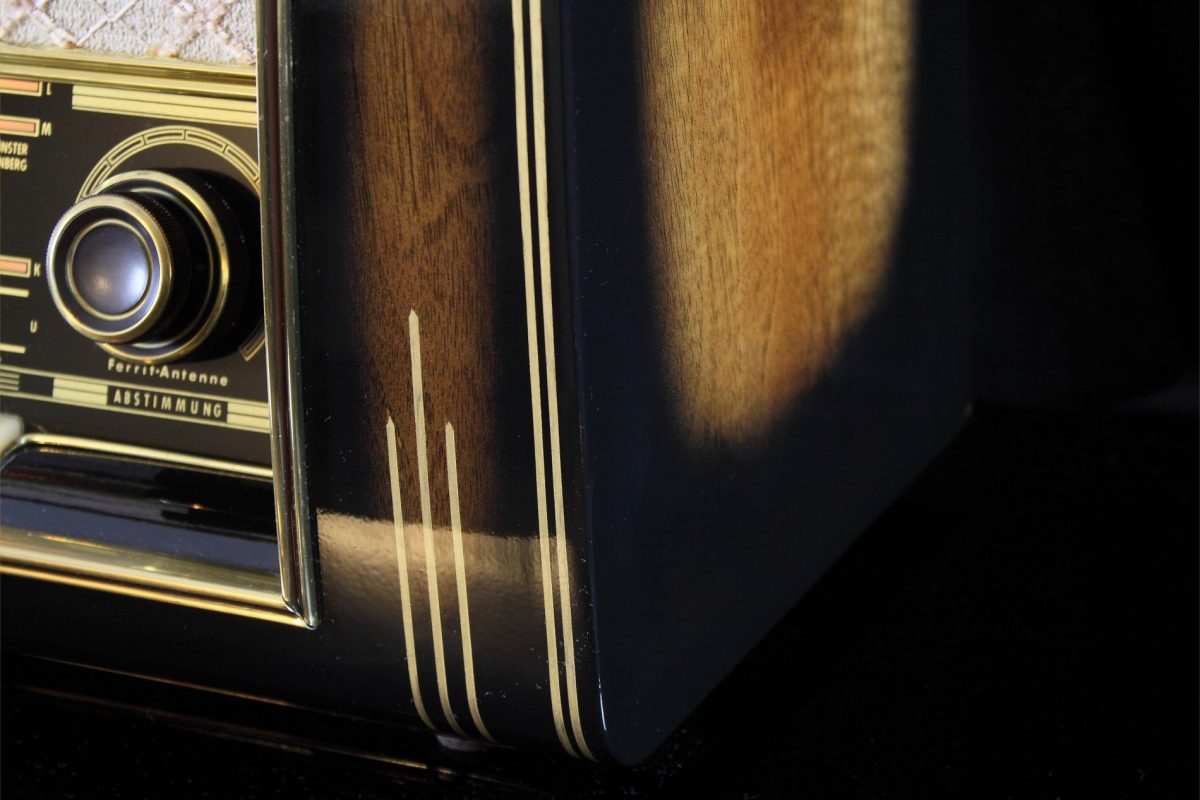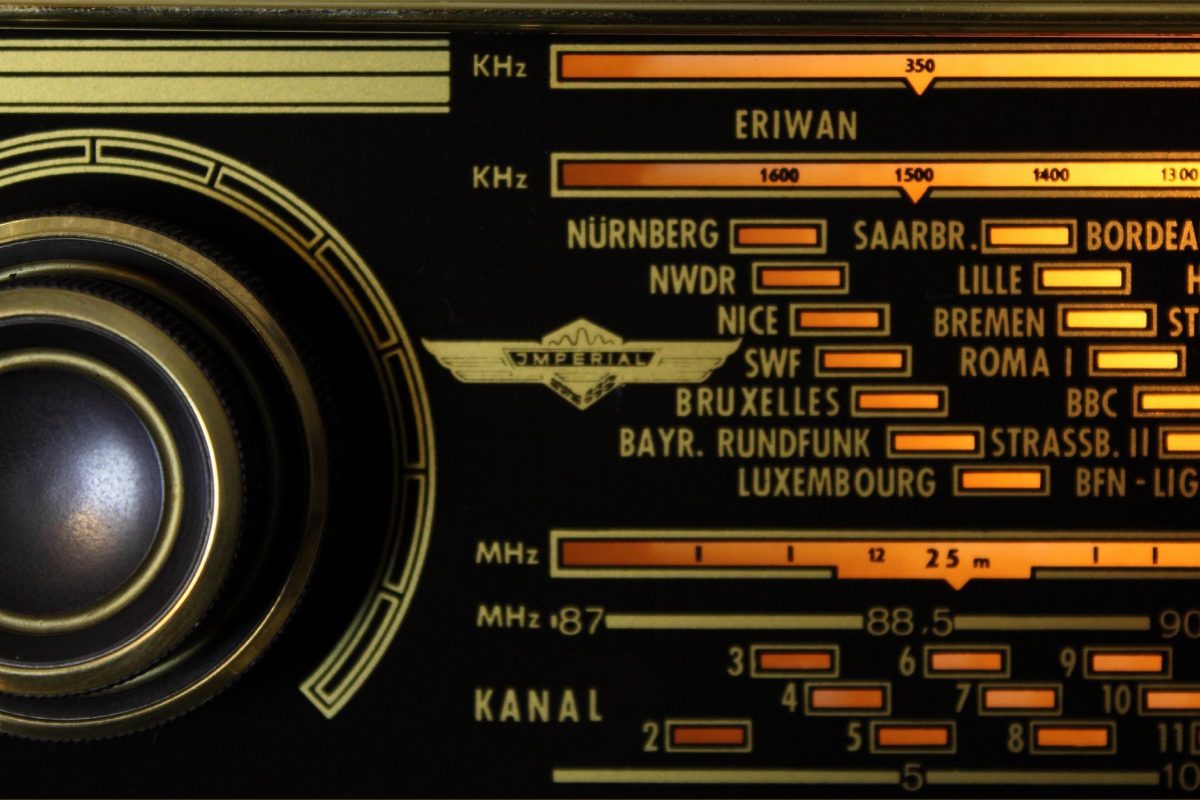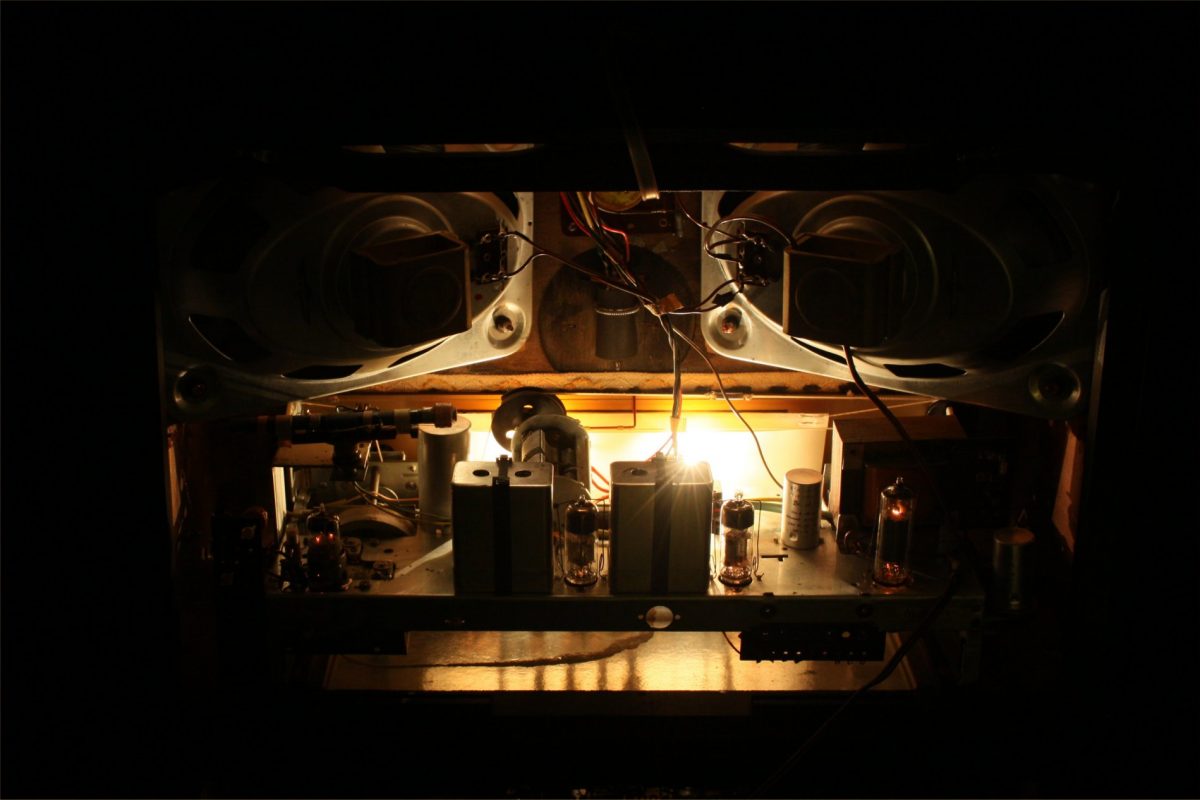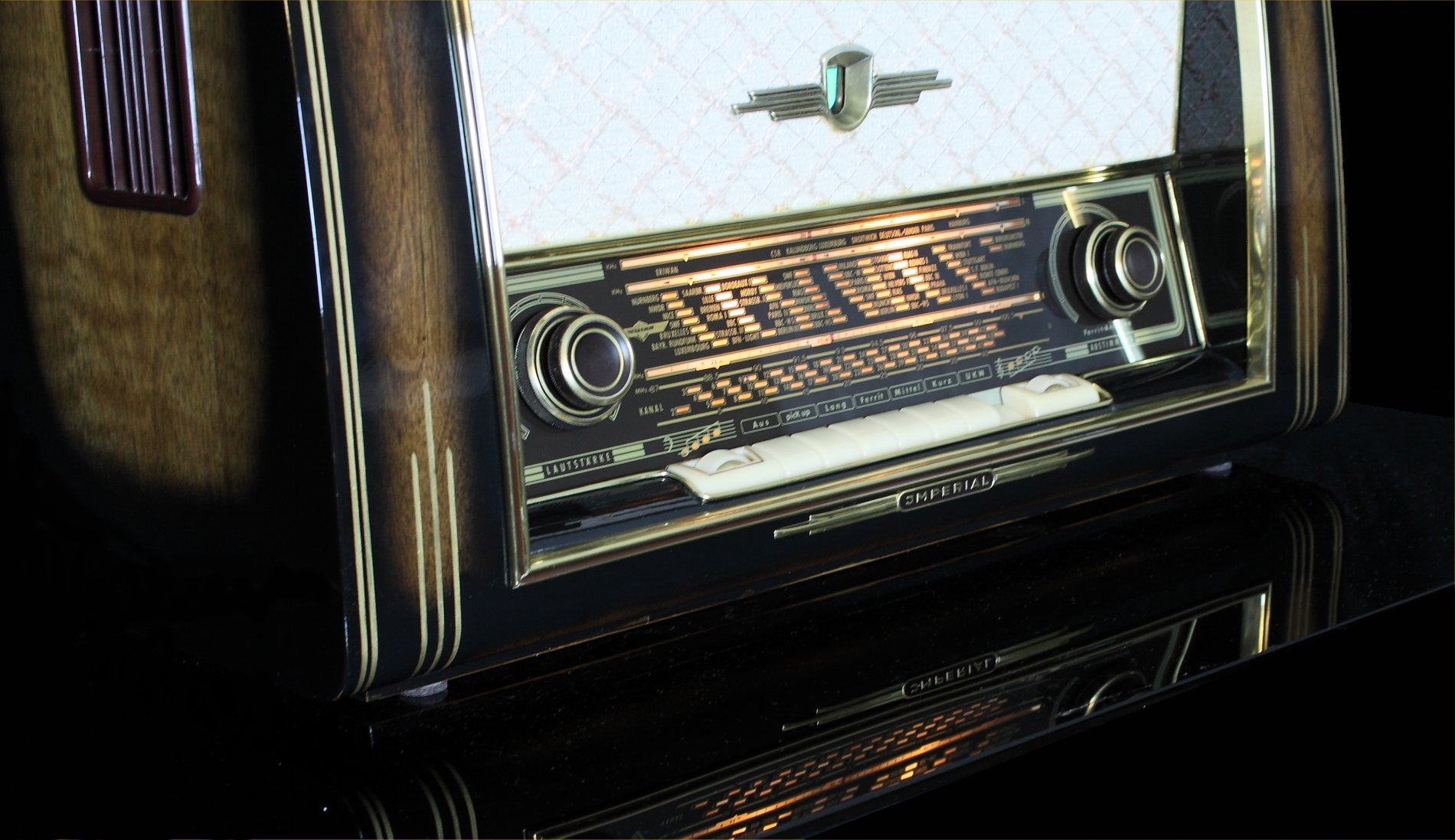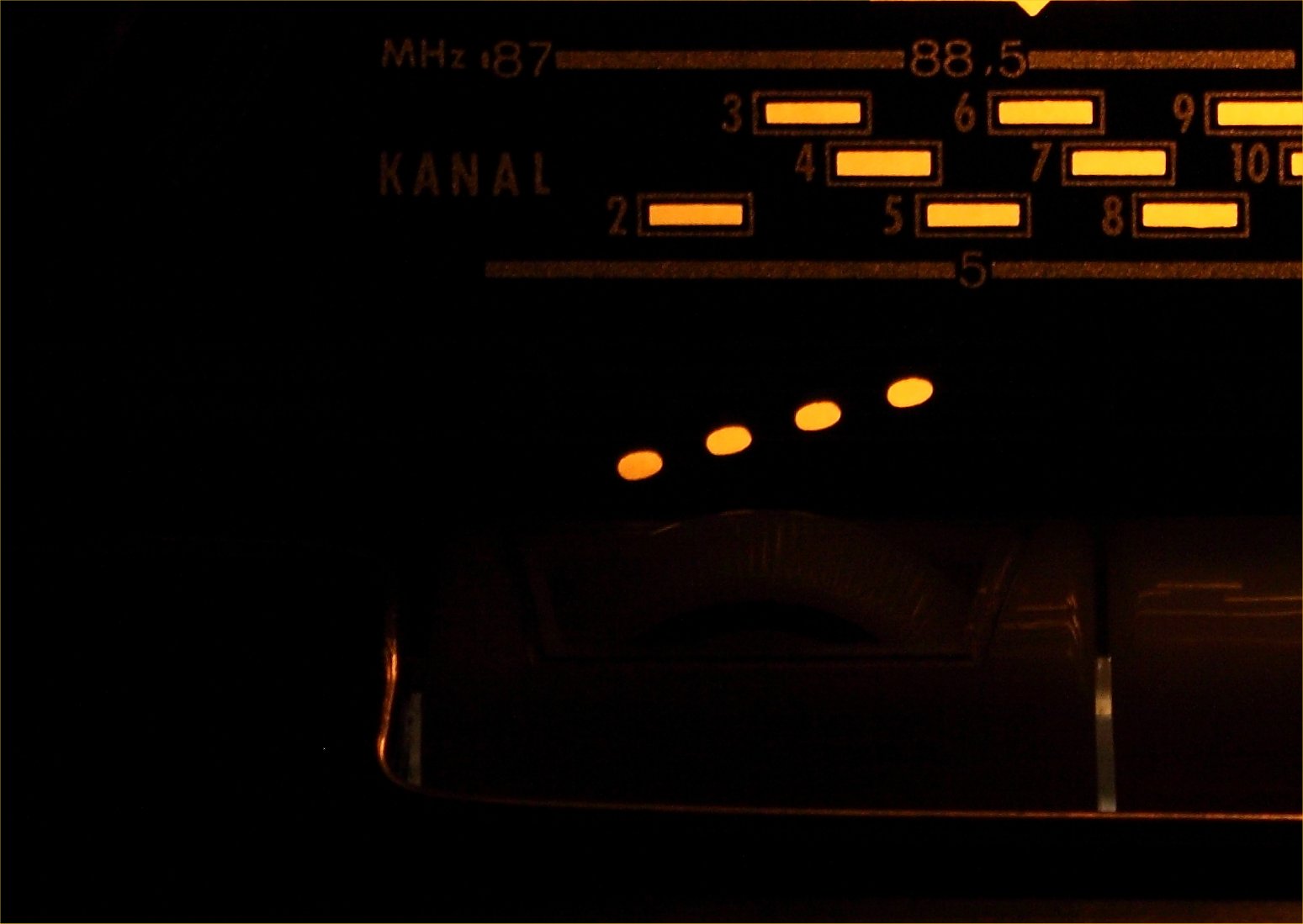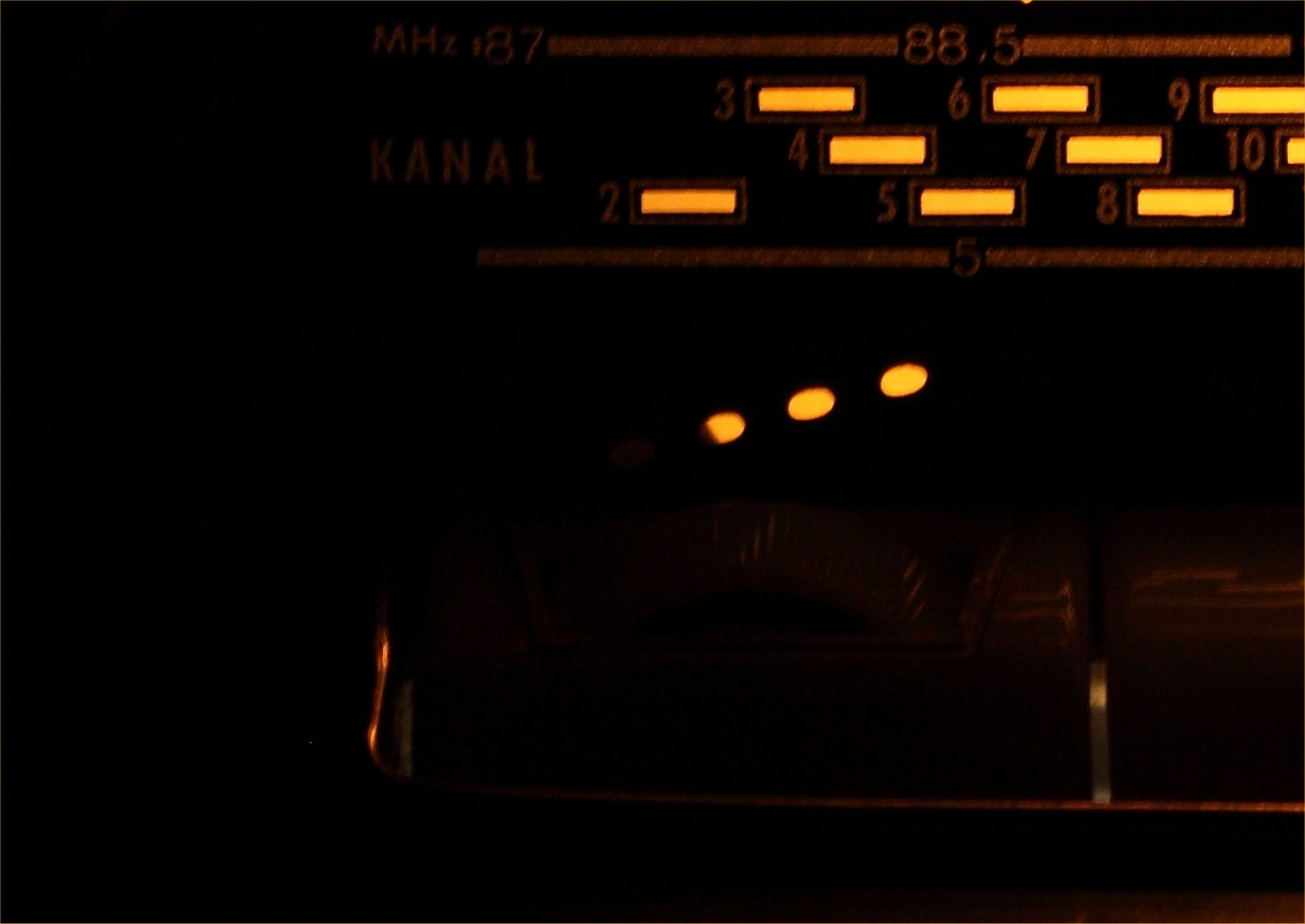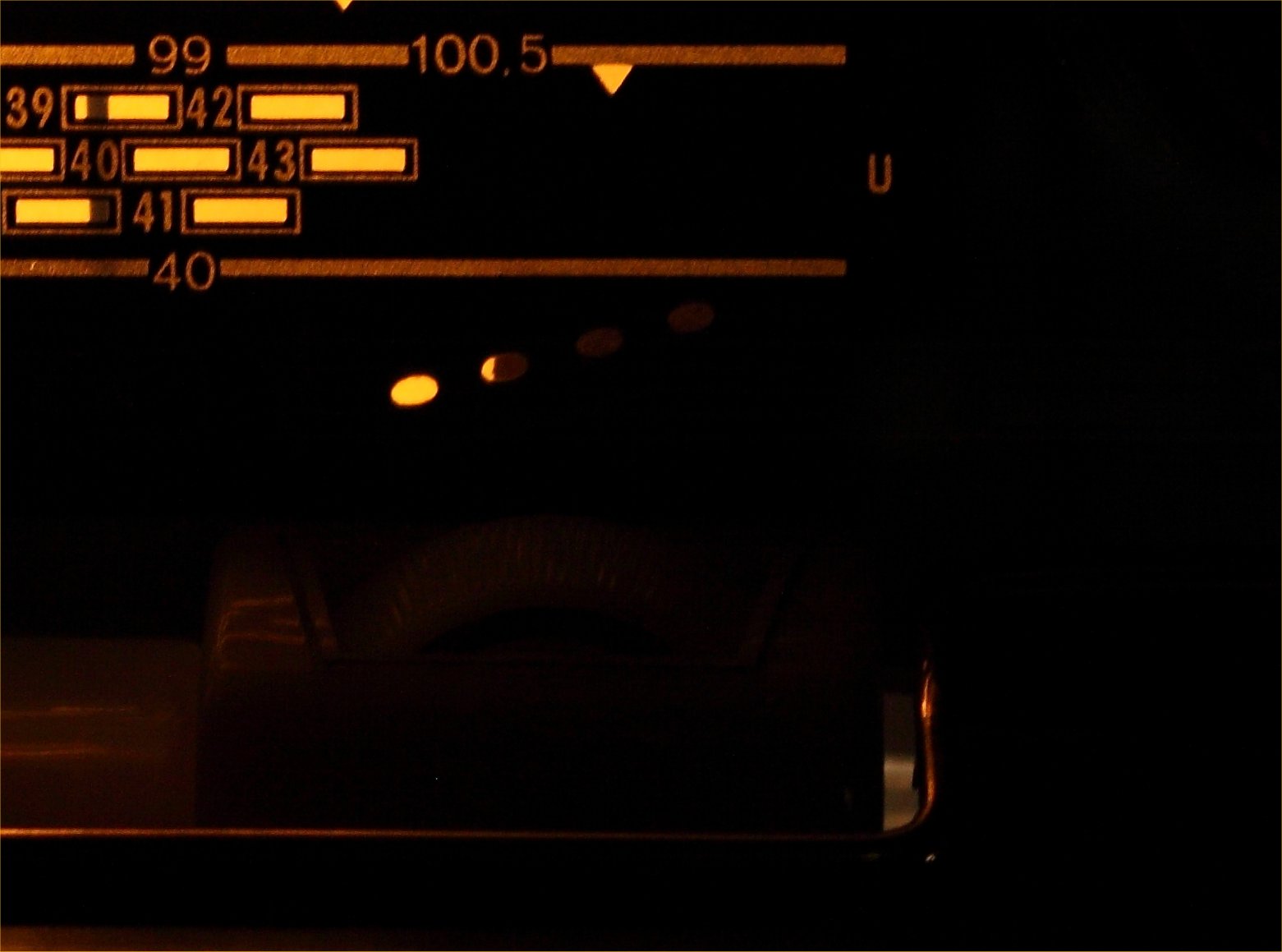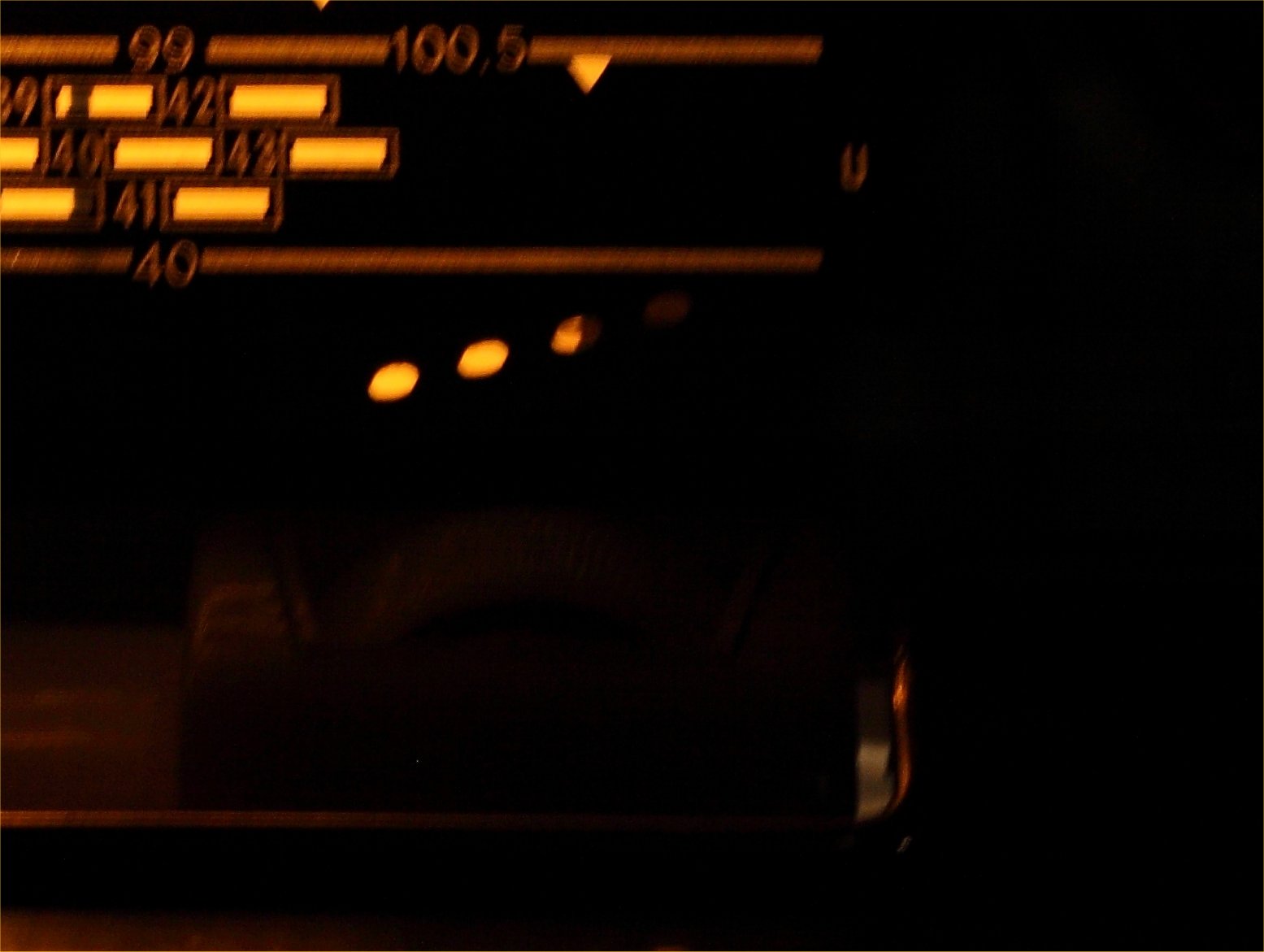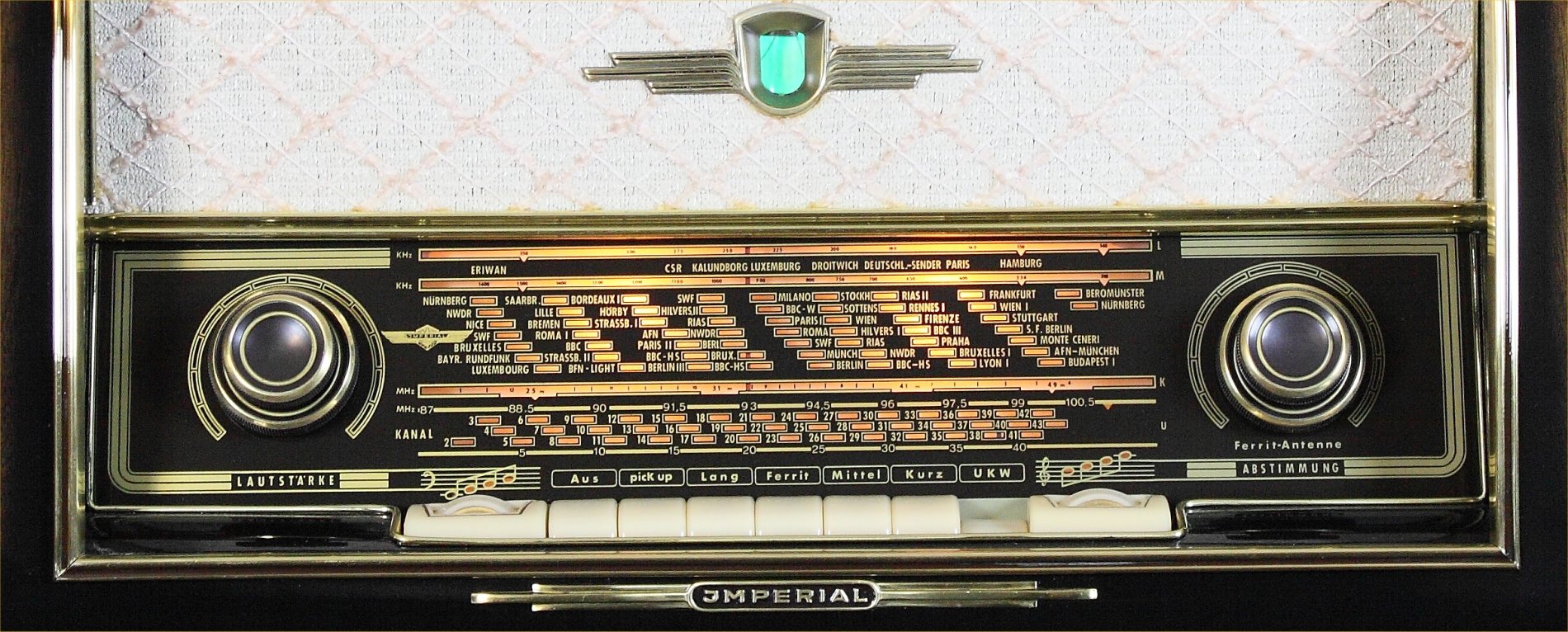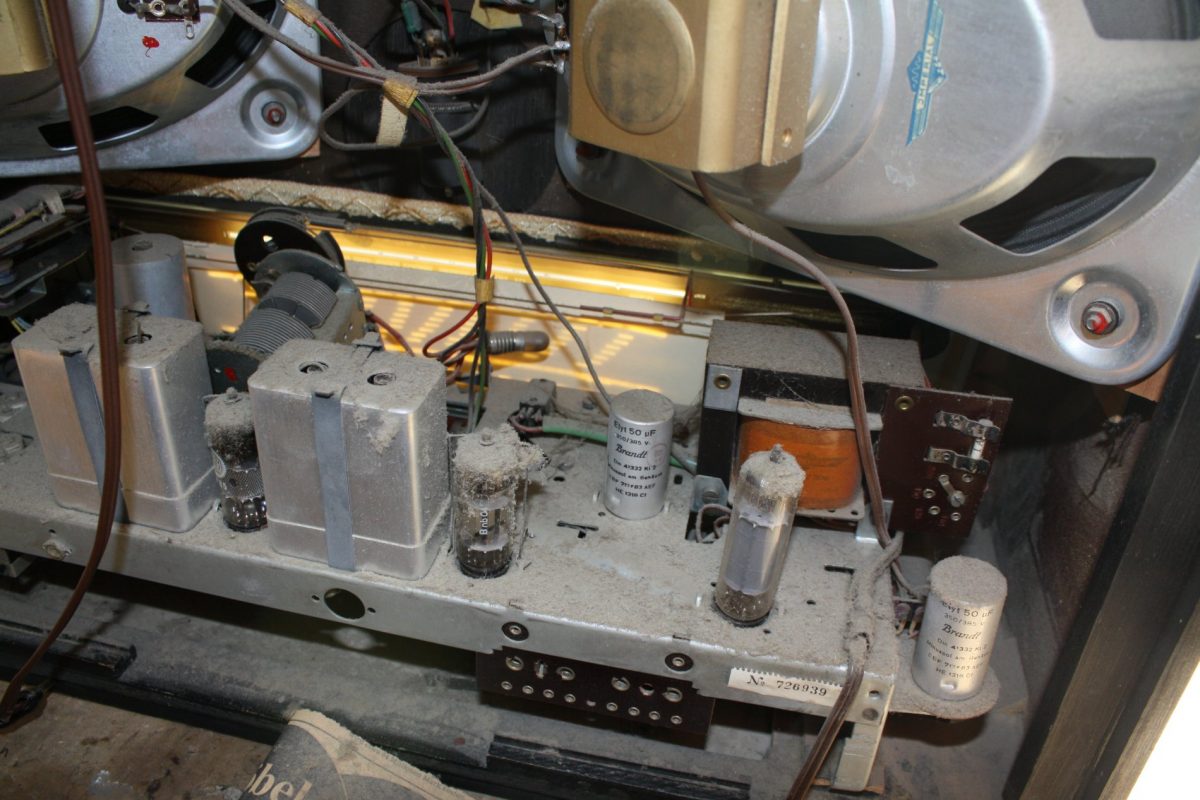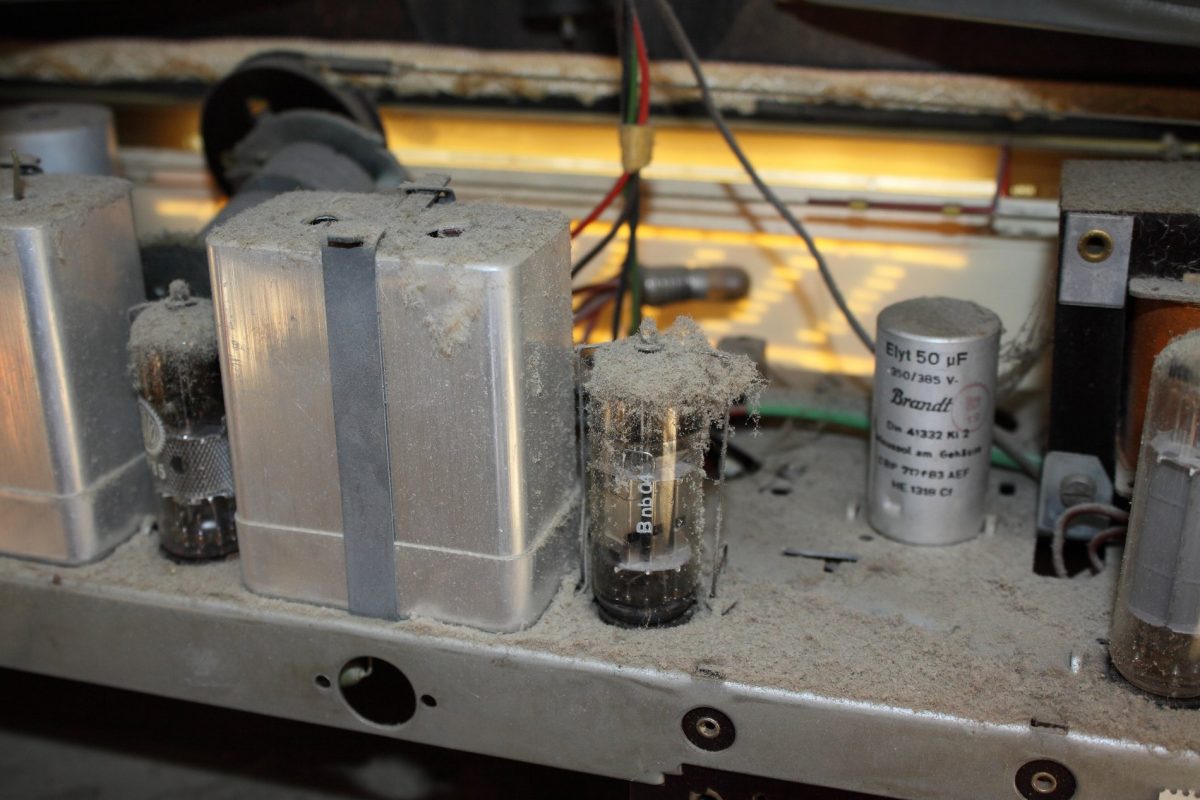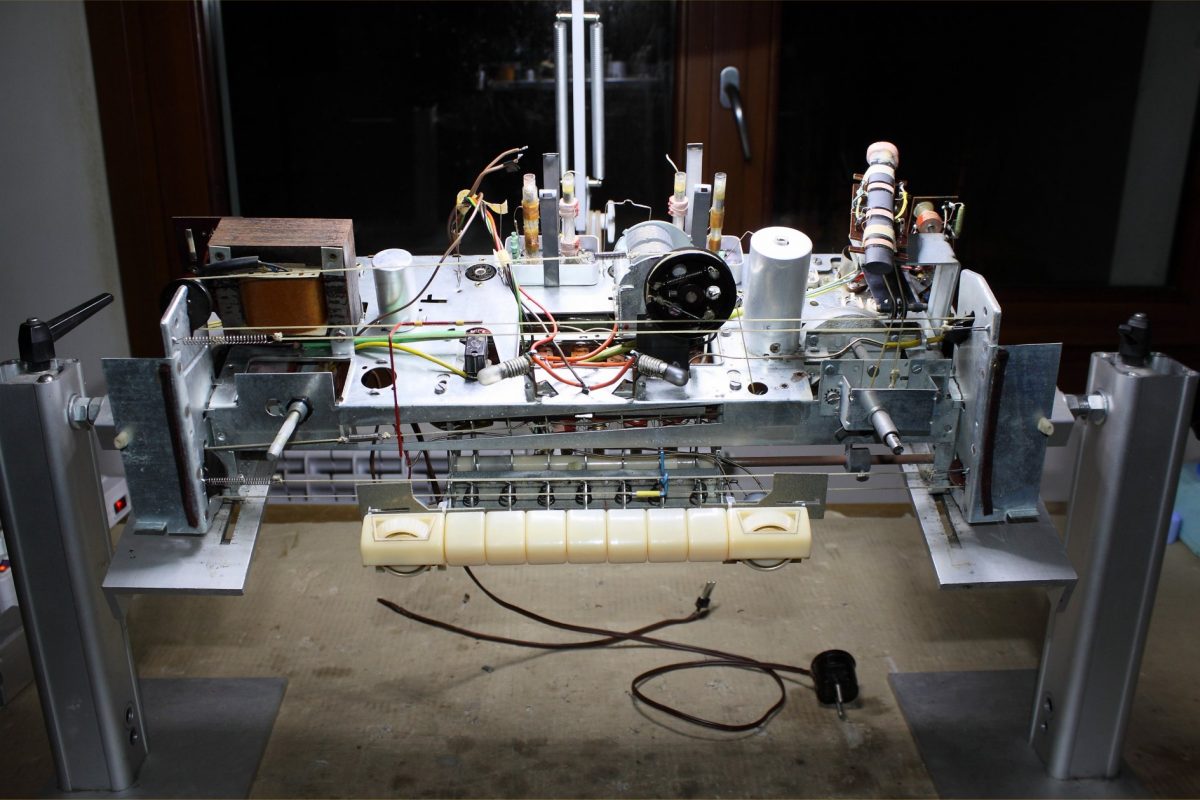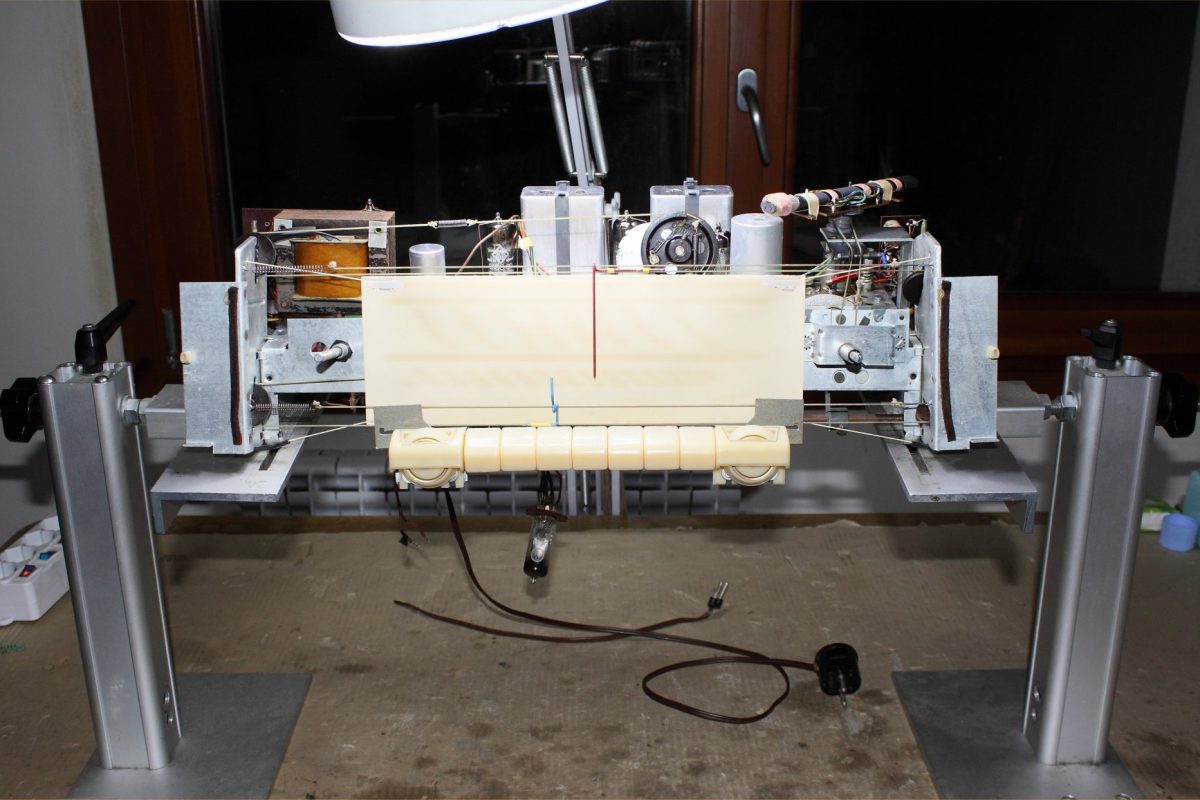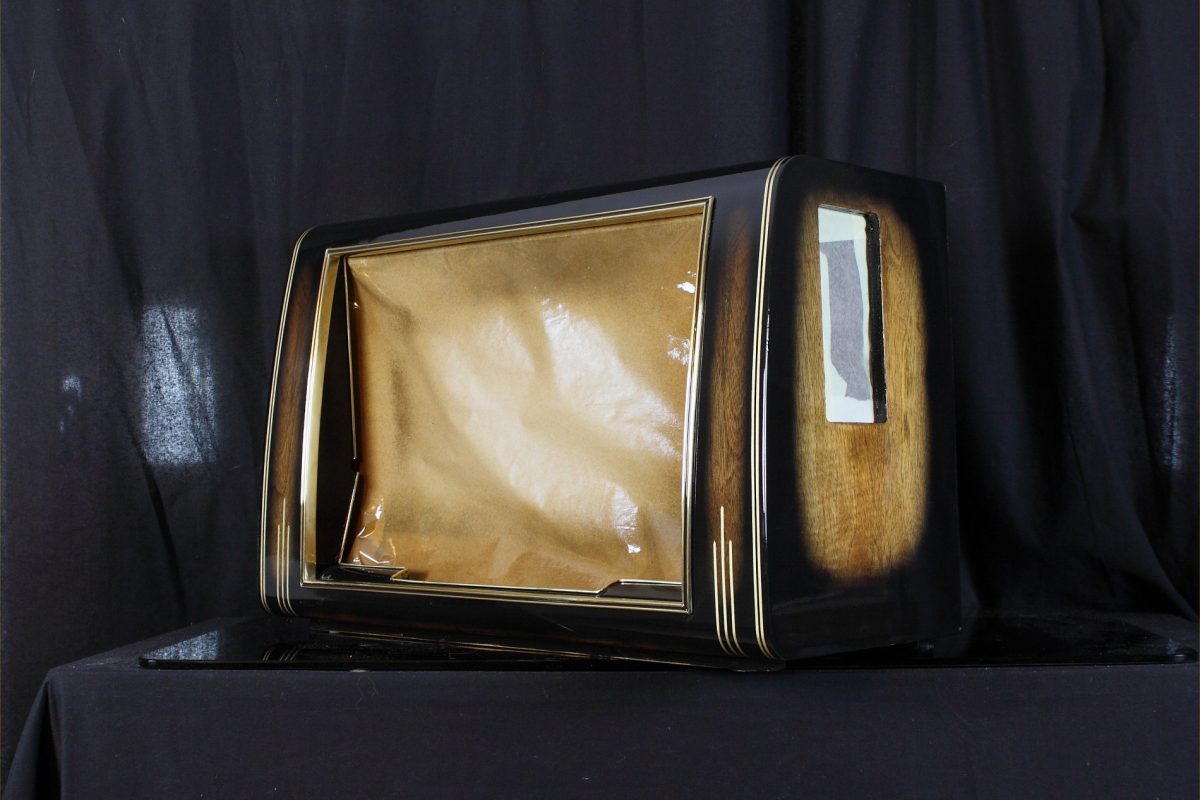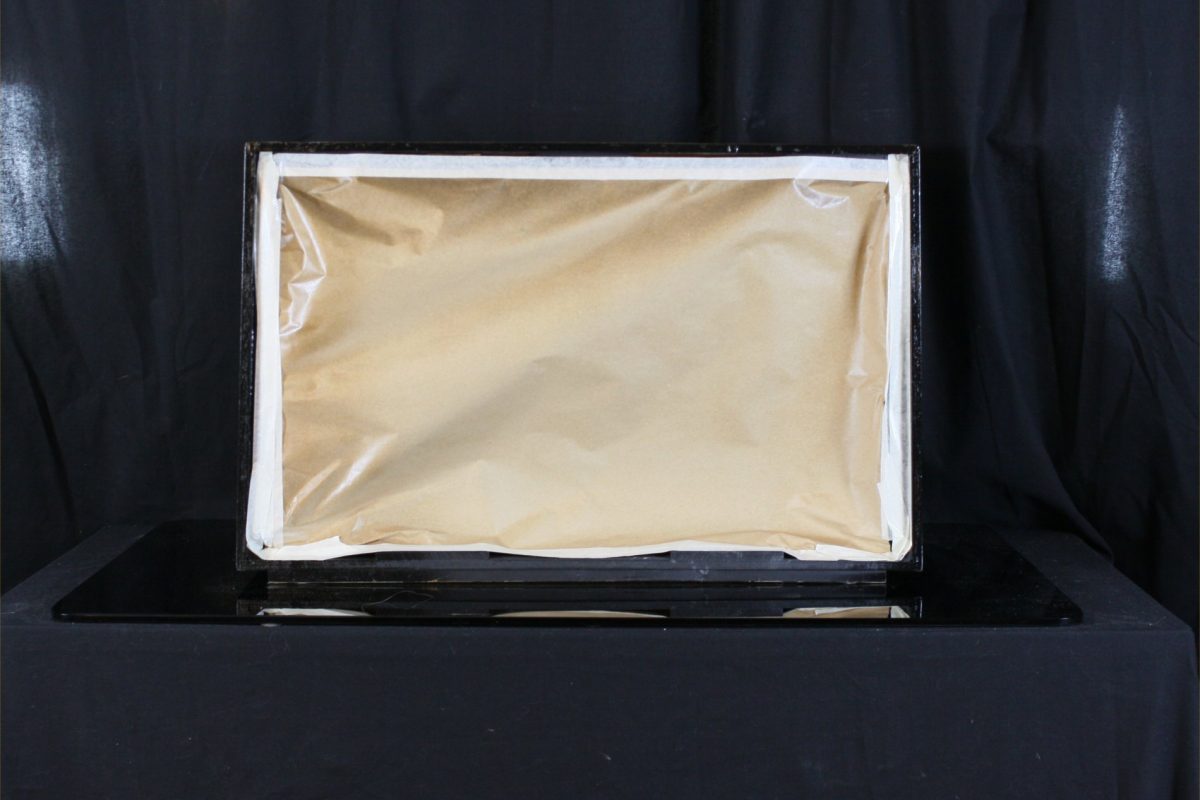 german radios - cn
german radios - cn
Imperial …
- by giovanni
IMPERIAL J406W STEREO
IMPERIAL J406W STEREO
Like all the Imperials, the Imperial J406W Stereo is also very beautiful.
 The cabinet has an unusual shape, slightly wider at the top. This peculiar stylistic choice gives the device a majesty that is not common to most of other radios.
The cabinet has an unusual shape, slightly wider at the top. This peculiar stylistic choice gives the device a majesty that is not common to most of other radios.
The golden vertical streaks, of different length and thickness, placed in the rounded front corners, remind of the grooves of the columns, increasing the impressiveness of the cabinet.
The particular manufacturing of the lateral canvases, where the weft intertwines with the warp in order to highlight some vertical lines, contributes to further hurl the silhouette of the cabinet.
The peculiar coloring of the wood, tending to red, and the shading adopted in the dyeing of the lower layer give further movement to the cabinet.
The final glossy painting completes the manufacturing.
The result of such stylistic choices and accurate workings is a slender, important and very elegant cabinet, easy to match with different types of furniture.
The sound is what I would call the “Family Sound” of the Imperial, clean trebles thanks to the electrostatic tweeter and very fast bass, without resonances, as they are reproduced by two elliptical speakers rather than just a very large one.
This device is particularly suitable for the reproduction of vocal music and electronic instruments.
Also on this model the name “stereo” is inappropriate. The device is monophonic. The use of two loudspeakers placed in an angled position does not make it stereophonic, the purpose is to allow a more uniform sound distribution in all directions.
Examining the circuit, an interesting peculiarity can be noticed, the polarization of the EL84 control grid is made by a negative voltage obtained from the power supply. The interesting thing is that a trimmer was inserted in the bias circuit, which allows to fix with precision the operating point in order to minimize the buzzing.
Of course, a feedback network is provided to linearize the frequency response.
The loudness circuit is obtained by tapping the preamplifier section from two taps on the volume potentiometer.
Also interesting is the equalizer controlled by the large central knob visible between the speaker panel and the display.
The use of the equalizer is explained later in the page.
The electronic section was clearly designed with the same care used for the cabinet.
The choice of the tracks of such a Teutonic brand was almost a judgement call. All the songs chosen in the playlist are dedicated to the music of German authors.
We are at the beginning of the 1200s. Art in Europe opens up to a noticeable internationalist impulse. The Minnesingers (love singers) in Germany, like the Trouvères in France, sing the beauty of love, nature and material happiness. Epic legends resemble each other, copy themselves, are adapted to one's own language. The exploits of the Christian Cavalry, composed of nobles from different nations, encourage this osmosis. It is in Germany, in this favourable climate, that the Ring of the Nibelungs appears. The Wartburg Castle was at the center of the German lyric and the reference to Wagner in his Tannhauser is clear here.
The first song is by Oswald von Wolkenstein, a late but highly refined Minnesinger. At this time the Nobility, with its values, is giving power to the bourgeoisie. The folk song is mixed with the Gregorian. The track in the playlist (A good noble man) is a good example of this.
From this series of artistic and cultural upheavals, the movement of the Cantor Masters was born.
With the second song we take a 600-years leap forward, we go visit the German opera with Carl Maria von Weber's Freischütz. This score made him the father of German musical Romanticism. The psychological research and the evocative drive are very strong in Weber's works, especially in this one. In the Freischüt we find prints of Beethoven and Mozart and this work will also serve as a stimulus for the French operatic school. Weber's numerous Lieds will also deserve a listening, in the near future.
With the third track we come to 1912. The listening here is more difficult at first, I am talking about Arnold Schomberg's Pierrot Lunaire, for speaking voice and instruments. Born in Vienna in 1874, Schomberg breaks with the sound of his predecessors, and that of his contemporaries like Strauss, experimenting abstract melodies without tonal supports, dissonances, to arrive to dodecaphony (compositions with 12 notes). The feature of music classified as “Expressionist” is the detachment from nature, tending towards more abstract productions, without material references. The connection with Expressionism and Cubism in painting appears clear. The difference between the Polytonality of some of Stravinski's works and the Atonality of those of Schomberg is also big.
The Pierrot Lunaire is based on a selection of tracks by the Belgian poet Albert Giraud.
With bold irreverence with the fourth song we get excited, without asking ourselves too many questions, with the beautiful Helene Fischer, who plays a great success of hers, Atemlos durch die Nacht (Breathless Through the Night). Helene Fischer is a singer, dancer and showoman, very popular in Germany. Her music is popular with young and old people, in the most modern cities as well as in the most conservative towns. Eclectic and reckless, yet extremely pragmatic personality, Helene is also involved in an association against child prostitution (roterkeil).
We close the playlist in peace with a beautiful track by Marcus Loeber, a German composer and pianist with a great experience and a generous artistic sensibility. From a strictly experiential point of view, together with Hildegard von Bingen's compositions, Marcus' piano songs are among the pieces that most realign me, when needed.
Below is his biography, entirely taken from his website.
-
BLUETOOTH
Bluetooth receiver embed
-
MULTI PLATFORM CONNECTION
Each radio is equipped with a cable for connection to any digital device.
TUBESOUND IMPROVEMENT
- Bluetooth receiver embed - The unit is equipped with a BLUETOOTH receiver powered directly by the receiver power supply. This makes it possible to control the amplifier from any external digital device as an IPAD, a Smartphone, or a sophisticated multimedia station. So you can hear your preferred web station or your lossesless file without cables on the room. Wireless Receiver can be equipped upon requests.
- Multi Platform Connection - A customized adaptation cable to connect any digital device as Iphone, Smartphone, Laptop, CD Player etc. will be provided with this radio. This special cable suits the different impedances between the modern equipment and the receiver. Furthermore the two stereo channels flow into one without increasing the load to the input unit.
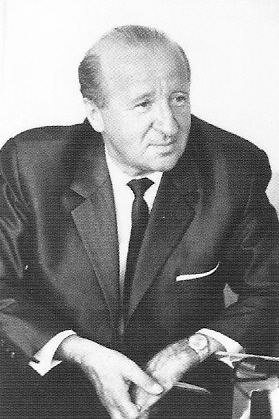
HISTORY
In 1923, long before the official launch of broadcasting in Germany, a little crew of specialists began AG in Staßfurt the development and production of radio devices.
At that time, workforce barely reached 20 people, but soon after the introduction of broadcasting in Germany, the number of employees grew to 400.
In 1927, more than 25.000 radios and a lot of components had been produced.
In 1928 it was the first German company to launch the superheterodyne receiver into the market.
The production of IMPERIAL receivers, which become known by the name “"Staßfurter Imperial", is started.
The products of this company quickly gain excellent reputation and sales increase to such an extent that the number of employees rises up to 600 in 1932.
In 1938 a more modern factory is built, of about 7000 square meters besides administration buildings and laboratories.
In 1939 the production increases and the number of employees rises up to 850.
During the war, the production of civil radio is interrupted, to make room to that of communication devices for Wehrmacht.
Another warehouse of 6000 square meters is built and the number of employees increases to 1700.
After the end of the War the company is expropriated but, thanks to the staff's strong persistence, the production is restarted.
In 1947, another company is created in Osterode / Harz under the name Continental Rundfunk GmbH.
In 1955 the number of employees rises up from 100 to over 500.
In 1958 the company is taken over by Gerhard Kubetschek, owner of KUBA, to whom the know how of the Continental Rundfunk are transferred.
The story of Kuba... is another story.

MAIN FEATURES
Year of production: 1956/57
Superheterodyne IF 468/10700
7 AM Circuits
19 FM Circuits
Wavebands:
Medium Waves(MW), Long Waves (LW)
Short waves (KW), FM (UKW)
Loudspeakers;
2 mid-woofer
1 electrostatic tweeter
Dimensions (LHD): 640 x 400 x 274 mm / 25.2 x 15.7 x 10.8 inch
Net weight: 15 kg / 33 lb 0.6 oz
6 Tubes: ECC85 ECH81 EF85 EABC80 EM80 EL84
Turnable ferrite Antenna for AM bands.

TONE CONTROL WITH LEVEL INDICATION
The tones control system is very efficient. Above the large tone control knobs there is a band that lights up gradually indicating the emphasis on the band on which it acts.
AERIALS
Inside the cabinet there is a dipole for FM reception and a ferrite rotating aerial for AM reception.
Ferrite aerial can be rotated from the outside to achieve a perfect tuning of the device in the AM.
In this picture see the rotation mechanism and the position indicator of the aerial.
The reception sensitivity with internal aerials is very good. This unit was in fact produced in a period when there were not many radio stations and those available fairly apart from each others.
Using an external aerial sensitivity is further increased.
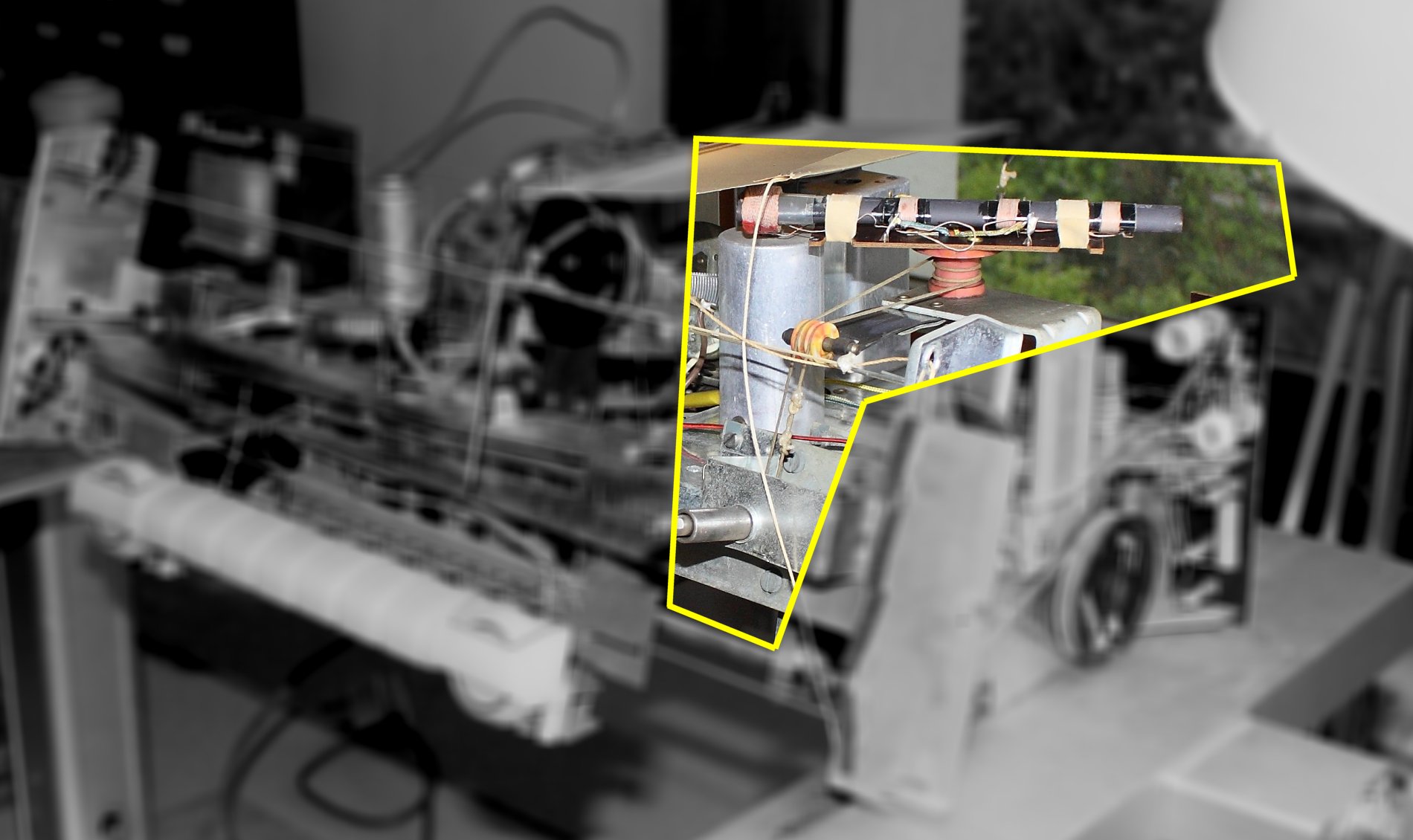

TUNING INDICATOR
The magic eye has of course been replaced.
EQUALIZER
The equalizer works by modifying the frequency response of the feedback network. It is controlled by the large horizontal knob visible in the photo. It has three positions but the variation is seamless so all intermediate positions are possible.
The positions are:
Jazz - treble enhancement
Orchester - Linear position
Solo - Mid tones enhancement
LOUDSPEAKERS
Two beautiful Isophon elliptical loudspeakers are located on the front, in a reclining position towards the sides.
On the sides there is an opening.
In this way the sound is perfectly audible both frontally and laterally.
Put to the test, this solution is better than the classical lateral positioning of the tweeters, as in this way the whole audible band is reproduced laterally, not only high frequences.
The loudspeakers are supported frontally by an efficient electrostatic loudspeaker.
The result is a very clean sound, especially in the listening of liquid music through bluetooth.
CONTROL PANEL
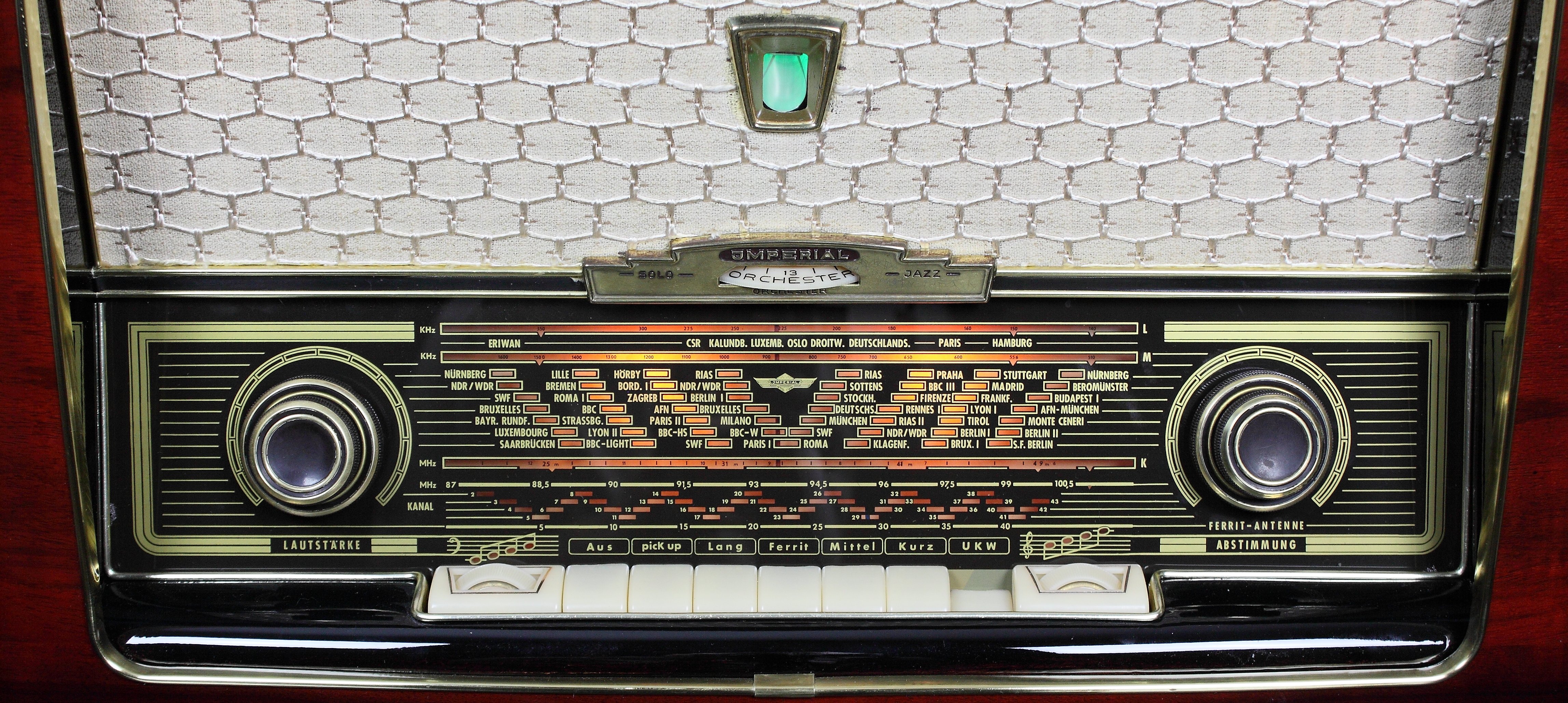
In the center of the loudspeaker panel the magic eye which indicates the perfect tuning of each station.
Below, in the center, we find the equalization buttons with three choices available: Solo, Orchester, Jazz.
On the display we find, from the left, the large volume knob, with loudness.
Below is the bass knob with its indicator.
The AM scale for Short, Medium and Long waves.
The FM scale.
Then in the order the keys:
- OFF
- turntable
- Long Wave
- Ferrite Antenna for MW and LW
- Medium Wave
- Short Wave
- FM
The treble knob with its indicator.
Coaxially to the latter, we find the Ferrite Antenna rotation knob.

REAR SIDE
Output for external speakers.
Socket for recorder (tonbandgerat).
Turntable input (Tonabnehmer)
AM and FM aerial inputs and ground socket.
RESTORING WORKS
THE USUAL AMAZING LAST IMAGE


